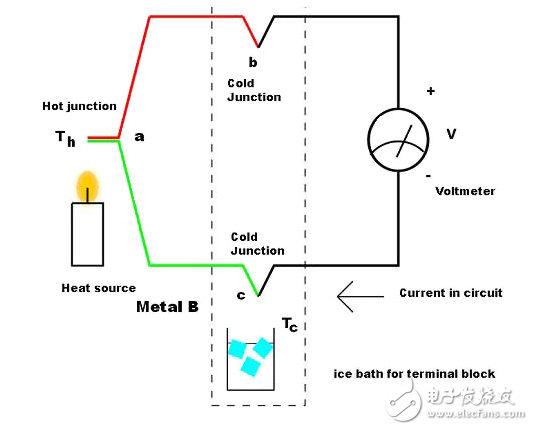
资料下载

选择放大器调理电路与热电偶接口
选择放大器/调理电路与热电偶接口
热电偶是用来测量温度的,是一种非常罕见的传感器,它实际上产生电压而不是改变电阻、电容或导电率。由于信号电平非常小,需要专门的高阻抗放大,以准确地拾取和放大热电偶信号,而不会影响或影响其精度。虽然通用运算放大器可以使用,但有专门为热电偶设计的一类专用放大器。
本文将研究热电偶的特性,并着重于与它们相连的放大器和调节电路。这些部件可以放大、电平转换,并抵消,补偿热电偶信息直接连接到A / D级嵌入式单片机,也可以用于驱动半导体分立器件如晶体管和继电器作为安全阀或限位开关。在这两种情况下,放大器负责确保精确的热电偶信息被保存和传播。

A tale of two metals
When two different metallic materials are in contact, the junction around the point of contact will generate a voltage that depends on the temperature difference between the junction and the rest of the conductors. Typically, induced voltages will be between 1 and 70 µV/°C for standard metal combinations. First noticed by Thomas Seebeck, this effect is commonly known as the thermoelectric effect, but it is also called the Seebeck effect in honor of the Estonian physicist.
In some cases, the voltage generated is proportional to the difference in temperature; other combinations of metals and alloys can produce a nonlinear proportional response. Both can create useful applications for thermocouples. The non-linear responses can be used as limit switches, while the (somewhat) linear responses can be used as a temperature sensor.
Since thermocouples measure the difference of a temperature between two distinct points, the voltage measurement is not a reflection of an absolute temperature. A cold junction can be maintained as a reference. This is a useful way of characterizing a thermocouple, since a simple medium, such as using ice as a calibration point, is easily replicated anywhere (Figure 1)。
声明:本文内容及配图由入驻作者撰写或者入驻合作网站授权转载。文章观点仅代表作者本人,不代表电子发烧友网立场。文章及其配图仅供工程师学习之用,如有内容侵权或者其他违规问题,请联系本站处理。 举报投诉
- 相关下载
- 相关文章





